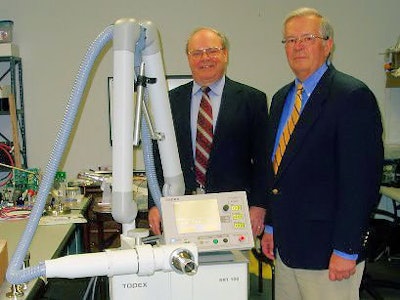
Anthony Pellegrino had been retired for just a couple of years when his entrepreneurial spirit was rekindled in 2003.
The founder and CEO of the former mammography and stereotactic biopsy systems manufacturer Lorad decided it was time to get back in the healthcare business. He contacted friend and former Lorad president and chief operating officer (COO) John M. Brenna, and soon the duo began laying the groundwork for another venture -- Topex.
"I enjoy the start-up phase itself," Topex CEO Pellegrino said, "starting from nothing and creating something."
With product development beginning in 2004, the Danbury, CT-based Topex today has created a mobile superficial radiation therapy (SRT) system designed specifically to treat skin cancer. The portable Topex SRT 100 weighs 310 lb, has a footprint of 29 x 30 inches, and uses a standard 120-volt line for electrical power.
The device received marketing clearance from the U.S. Food and Drug Administration on January 9, 2007, and the European CE Mark in February 2007. With both certifications in hand, Topex has begun to build a worldwide dealer network, reaching out to many of the distributors Pellegrino and Brenna knew from their Lorad days.
 |
| President John Brenna (left) and CEO Anthony Pellegrino (right) stand next to the Topex SRT 100. Photo by Wayne Forrest. |
The plan is to sign 20 to 25 dealers worldwide in the first half of 2007, and have as many as 70 to 100 dealers on board worldwide by the end of the year.
Topex's first contract is with a Danish dealer to cover the Scandinavian countries. The company recently sold its first SRT 100 in Michigan, and has an agreement for a May installation at the Maimonides Medical Center in New York City.
SRT 100 carries a list price of $89,500 and features applicators ranging in size from 1 cm to 10 cm to collimate the radiation beam to a specific location on the skin. For safety purposes, the applicators have a disposable plastic ring around the end of each device, rather than the traditional glass design.
The base unit consists of a high-voltage generator, power supply components, and cooling system. On the outside of SRT 100 is the positioning arm on which the x-ray tube housing is assembled. The unit produces filtered low-energy (70 and 100 kV) radiation from a conventional ceramic x-ray tube.
Pellegrino said the typical treatment radiation dose would be about 2 Gy with a patient receiving five and 10 treatments, and sometimes more, depending on the extent of the cancer.
"For clinical purposes, there is no scarring or incisional surgery," added Brenna, who serves as Topex president and who previously served stints at thermal breast imaging developer Computerized Thermal Imaging of Ogden, UT, and in the x-ray division of Philips Medical Systems of Andover, MA. "If surgery is required, this (SRT 100) will work with the surgeon as an adjunctive device for therapy" to make sure all cancer cells are removed.
The U.S. Centers for Medicare and Medicaid Services (CMS) has current procedural terminology (CPT) codes for superficial skin cancer treatment, so there is no reimbursement issue for the procedure.
Market research
Pellegrino said that part of the credit for this start-up venture goes to an old friend who refurbishes imaging equipment. He told Pellegrino about the opportunity in the superficial radiation treatment market, which has a need for new devices.
Topex is touting SRT 100's compact, mobile design as a replacement for wall-, floor-, and ceiling-mounted superficial radiation treatment devices that have been in use for decades. When older systems were replaced in the past, many healthcare facilities chose to invest in linear accelerators for radiation oncology applications.
"We also found that the older superficial x-ray systems were left by the wayside by the larger companies," Brenna said. "Many of them still out there being used to treat skin cancer are between 30 and 50 years old."
Skin cancers are the most commonly diagnosed cancers, with more than 1 million new cases in the U.S. every year, according to the American Cancer Society (ACS). The National Cancer Institute (NCI) estimates that one of seven people is at risk for developing some form of skin cancer during his or her lifetime. More than 50% of skin cancer cases occur in adults older than 60 years -- with men twice as likely to have skin cancer than women.
"If you look at the demographics with the older population and how many people will be over 60 in the future, they are the people who will need this kind of treatment," Pellegrino said.
With those demographics and expectations that skin cancer rates will grow 4% annually, Topex is targeting the 14,000 dermatology offices in the U.S., as well as the country's 15,000 nursing homes. "It is hard for older folks to be taken to the other facilities to be treated for skin cancer," Brenna added.
Danbury operation
Topex's Danbury facility covers approximately 9,000 sq ft, and with 6,000 sq ft remaining unoccupied, it has ample room for expansion. Subcontractors provide the components, and SRT 100 is assembled in Danbury.
Potential production capacity is difficult to estimate right now. Pellegrino said the company will "build to a forecast," as orders arrive for SRT 100, with early expectations of producing 50 units per year.
Topex currently has six employees -- regulatory officer Phil Juhas and senior engineers Richard Schutz, Francis Carrasco, and Alex Kreizman. All four men -- like Pellegrino and Brenna -- are former Lorad employees.
"We worked well back then," Brenna said. "Now that we are a lot older, we have a mutual respect for each other's talents."
By Wayne Forrest
AuntMinnie.com staff writer
April 9, 2007
Copyright © 2007 AuntMinnie.com



















